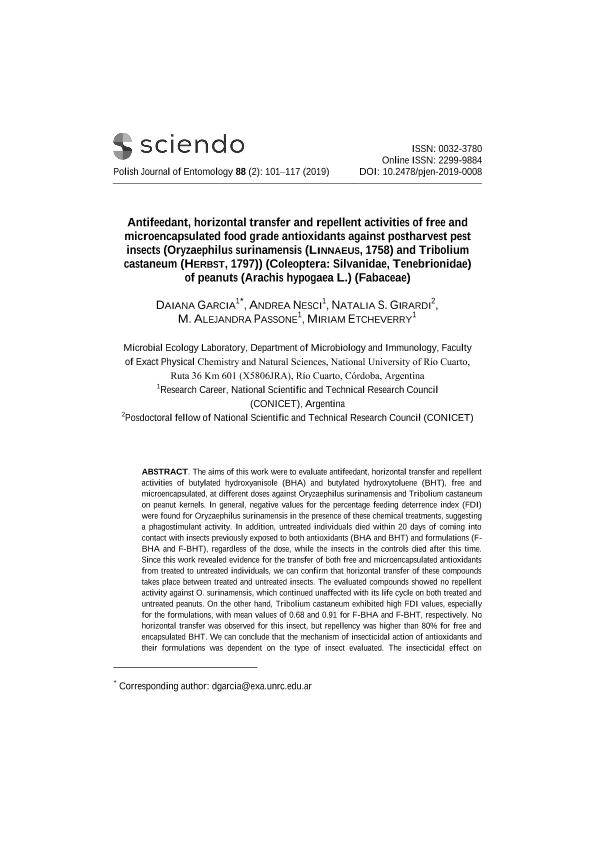Mostrar el registro sencillo del ítem
dc.contributor.author
García, Daiana

dc.contributor.author
Nesci, Andrea Verónica

dc.contributor.author
Girardi, Natalia Soledad

dc.contributor.author
Passone, Maria Alejandra

dc.contributor.author
Etcheverry, Miriam Graciela

dc.date.available
2020-10-26T20:24:48Z
dc.date.issued
2019-06
dc.identifier.citation
García, Daiana; Nesci, Andrea Verónica; Girardi, Natalia Soledad; Passone, Maria Alejandra; Etcheverry, Miriam Graciela; Antifeedant, horizontal transfer and repellent activities of free and microencapsulated food grade antioxidants against postharvest pest insects (Oryzaephilus surinamensis (Linnaeus, 1758) and Tribolium castaneum (Herbst, 1797)) (Coleoptera: Silvanidae, Tenebrionidae) of peanuts (Arachis hypogaea L.) (Fabaceae); Sciendo; Polish Journal of Entomology; 88; 2; 6-2019; 101-117
dc.identifier.issn
0032-3780
dc.identifier.uri
http://hdl.handle.net/11336/116870
dc.description.abstract
The aims of this work were to evaluate antifeedant, horizontal transfer and repellent activities of butylated hydroxyanisole (BHA) and butylated hydroxytoluene (BHT), free and microencapsulated, at different doses against Oryzaephilus surinamensis and Tribolium castaneum on peanut kernels. In general, negative values for the percentage feeding deterrence index (FDI) were found for Oryzaephilus surinamensis in the presence of these chemical treatments, suggesting a phagostimulant activity. In addition, untreated individuals died within 20 days of coming into contact with insects previously exposed to both antioxidants (BHA and BHT) and formulations (F- BHA and F-BHT), regardless of the dose, while the insects in the controls died after this time. Since this work revealed evidence for the transfer of both free and microencapsulated antioxidants from treated to untreated individuals, we can confirm that horizontal transfer of these compounds takes place between treated and untreated insects. The evaluated compounds showed no repellent activity against O. surinamensis, which continued unaffected with its life cycle on both treated and untreated peanuts. On the other hand, Tribolium castaneum exhibited high FDI values, especially for the formulations, with mean values of 0.68 and 0.91 for F-BHA and F-BHT, respectively. No horizontal transfer was observed for this insect, but repellency was higher than 80% for free and encapsulated BHT. We can conclude that the mechanism of insecticidal action of antioxidants and their formulations was dependent on the type of insect evaluated. The insecticidal effect on Oryzaephilus surinamensis could have been due to the direct intake of the chemical compounds added, whereas the negative effect on Tribolium castaneum could have been caused by starvation.
dc.format
application/pdf
dc.language.iso
eng
dc.publisher
Sciendo
dc.rights
info:eu-repo/semantics/openAccess
dc.rights.uri
https://creativecommons.org/licenses/by-nc-sa/2.5/ar/
dc.subject
ANTIOXIDANTS
dc.subject
BHA
dc.subject
BHT
dc.subject
INSECTICIDE
dc.subject
MICROCAPSULES
dc.subject
ORYZAEPHILUS SURINAMENSIS
dc.subject
PEANUT
dc.subject
TRIBOLIUM CASTANEUM
dc.subject.classification
Biología Celular, Microbiología

dc.subject.classification
Ciencias Biológicas

dc.subject.classification
CIENCIAS NATURALES Y EXACTAS

dc.title
Antifeedant, horizontal transfer and repellent activities of free and microencapsulated food grade antioxidants against postharvest pest insects (Oryzaephilus surinamensis (Linnaeus, 1758) and Tribolium castaneum (Herbst, 1797)) (Coleoptera: Silvanidae, Tenebrionidae) of peanuts (Arachis hypogaea L.) (Fabaceae)
dc.type
info:eu-repo/semantics/article
dc.type
info:ar-repo/semantics/artículo
dc.type
info:eu-repo/semantics/publishedVersion
dc.date.updated
2020-10-22T18:18:14Z
dc.identifier.eissn
2299-9884
dc.journal.volume
88
dc.journal.number
2
dc.journal.pagination
101-117
dc.journal.pais
Polonia

dc.journal.ciudad
Varsovia
dc.description.fil
Fil: García, Daiana. Universidad Nacional de Rio Cuarto. Facultad de Ciencias Exactas Fisicoquímicas y Naturales. Departamento de Microbiología e Inmunología. Cátedra de Ecología Microbiana; Argentina. Consejo Nacional de Investigaciones Científicas y Técnicas; Argentina
dc.description.fil
Fil: Nesci, Andrea Verónica. Consejo Nacional de Investigaciones Científicas y Técnicas; Argentina. Universidad Nacional de Rio Cuarto. Facultad de Ciencias Exactas Fisicoquímicas y Naturales. Departamento de Microbiología e Inmunología. Cátedra de Ecología Microbiana; Argentina
dc.description.fil
Fil: Girardi, Natalia Soledad. Universidad Nacional de Rio Cuarto. Facultad de Ciencias Exactas Fisicoquímicas y Naturales. Departamento de Microbiología e Inmunología. Cátedra de Ecología Microbiana; Argentina. Universidad Nacional de Río Cuarto. Facultad de Ciencias Exactas Fisicoquímicas y Naturales. Instituto de Investigación en Micología y Micotoxicología. - Consejo Nacional de Investigaciones Científicas y Técnicas. Centro Científico Tecnológico Conicet - Córdoba. Instituto de Investigación en Micología y Micotoxicología; Argentina
dc.description.fil
Fil: Passone, Maria Alejandra. Universidad Nacional de Rio Cuarto. Facultad de Ciencias Exactas Fisicoquímicas y Naturales. Departamento de Microbiología e Inmunología. Cátedra de Ecología Microbiana; Argentina. Consejo Nacional de Investigaciones Científicas y Técnicas; Argentina
dc.description.fil
Fil: Etcheverry, Miriam Graciela. Universidad Nacional de Rio Cuarto. Facultad de Ciencias Exactas Fisicoquímicas y Naturales. Departamento de Microbiología e Inmunología. Cátedra de Ecología Microbiana; Argentina. Consejo Nacional de Investigaciones Científicas y Técnicas; Argentina
dc.journal.title
Polish Journal of Entomology
dc.relation.alternativeid
info:eu-repo/semantics/altIdentifier/doi/http://dx.doi.org/10.2478/pjen-2019-0008
Archivos asociados
